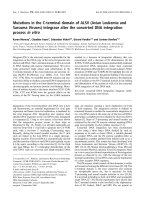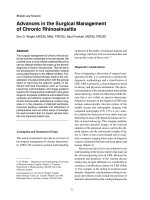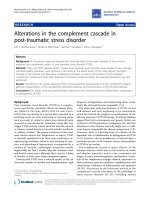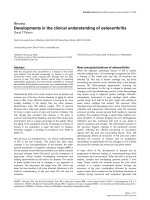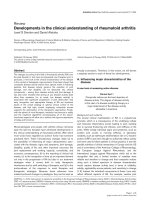Báo cáo y học: " Mutations in the E2-PePHD region of hepatitis C virus genotype-3a and correlation with response to interferon and ribavirin combination therapy in Pakistani patients" pptx
Bạn đang xem bản rút gọn của tài liệu. Xem và tải ngay bản đầy đủ của tài liệu tại đây (219.74 KB, 5 trang )
SHORT REPOR T Open Access
Mutations in the E2-PePHD region of hepatitis C
virus genotype-3a and correlation with response
to interferon and ribavirin combination therapy
in Pakistani patients
Samia Afzal, Muhammad Idrees
*
, Madiha Akram, Zunaira Awan, Bushra Khubaib, Mahwish Aftab, Zareen Fatima,
Sadaf Badar, Abrar Hussain
Abstract
Hepatitis C is a major health problem affecting more than 200 million individuals in the world. Current treatment
regimen consisting of interferon alpha and ribavirin does not always succeed in eliminating the virus completely
from patient’s body. One of the mechanisms by which virus evades the antiviral effect of interferon alpha involves
protein kinase (PKR) eukaryotic initiation factor 2 alpha (eIF2a) phosphorylation homology domain (PePHD). This
domain in genotype 1 strains is reportedly homologous to PKR and its target eIF2a. By binding to PKR, PePHD inhi-
bits its activity and therefore cause virus to evade antiviral activity of interferon (IFN). Many studies have correlated
substitutions in this domain to the treatment response and lead to inconclusive results. Some studies suggested
that substitutions favor response while others emphasized that no correlation exists. In the present study we there-
fore compared sequences of PePHD domain of thirty one variants of six hepatitis C virus patients of genotype 3.
Three of our HCV 3a infe cted patients showed rapid virological response to interferon alpha and ribavirin combina-
tion therapy whereas the remaining three had breakthrough to the same combination therapy. It is found that
PePHD domain is not entirely conserved and has substitutions in some isolates irrespective of the treatment
response. However substitution of glutamine (Q) with Leucine (L) in one of the breakthrough responders made it
more identical to HCV genotype 1a. These substitutions in the breakthrough responders also tended to increase
average hydrophilic activity thus making binding of PePHD to PKR and inhibition of PKR more favorable.
Findings
Hepatitis C Virus (HCV) is a major health concern
worldwide with current estimates of more than 200 mil-
lion affected individuals [1]. In Pakistan 17 million peo-
ple are infected and about 20% are carriers for HCV [2].
In 60-80% cases HCV may lead to hepatocellular carci-
noma (HCC) [3]. It comprises of 9600 nucleotides that
predetermines a polypeptide containing 3010-3033
amino acids and encode 3 structural (Core, E1, E2) and
7 nonstructural (p7, NS2, NS3, NS4A-B, and NS5A-B)
proteins [4].
Current approved therapy for HCV is interferon alpha
[5] in combination with ribavirin [6] administered for 24
to 48 weeks but it does not eliminate virus completely
in 50-80% of the patients [7] . Many vir al and host fac-
tors are involved in t he response to interferon therapy.
Viral factors that favor sustained virological response to
IFN therapy includes HCV genotypes other than g eno-
type 1 and low viral load [8].
After death of cells interferon is released and in
response neighboring cells release PKR [9]. One of the
mechanisms by which IFN hamper HCV replication
involves protein kinase (PKR) which is activated by dou-
ble stranded RNA. Interferon alpha induces autopho-
sphorylation of protein kinase by binding to it and
phosphorylated PKR which in turn phosphorylates
eukaryotic initiation factor 2 alpha (eIF2a) and as a con-
sequence HCV RNA transcription is halted. However
HCV has also evolved certain mechanisms to overcome
* Correspondence:
National Centre of Excellence in Molecular Biology, 87-West Canal Bank Road
Thokar Niaz Baig Lahore-53700, University of the Punjab, Lahore, Pakistan
Afzal et al. Virology Journal 2010, 7:377
/>© 2010 Afzal et al; licensee BioMed Central Ltd. This is an Open Access article distributed u nder the terms of the Creative Comm ons
Attribution License (http://creativecommo ns.org/licenses/by/2.0 ), which permits unrestricted use, distribution, and reproduction in
any medium, provide d the original work is properly cited.
the antiviral activity of interferon. Such as E2 protein
that carries a 12 amino acid domain called as PKR-
eIF2a phosphorylation homo logy domain (PePHD)
which binds to PKR and inhibits its activity thereby
inhibiting the antiviral effects of interferon alpha which
ultimately leads to viral persistence. This binding is
because of the similarity of this PePHD d omain with
phosphorylation domain of PKR and eIF2a [10].
In order to find out whether PePHD region of E2 gene
shows any promising results for interferon treatment
response of HCV patients we investigated six HCV
patients. Baseline serum samples from six HCV patient s
of genotype 3a subjected to Interferon a lpha and riba-
virin combination therapy. Three patients ( R1, R2, and
R3 were rapid responders characterized by negative
HCV RNA (>500 IU/ml) after 4 weeks o f treatment.
Two patients (BT) were breakthrough virological
responders charact erized by reappearance of HCV RNA
at the end of treatment. One of the patients was defined
as end of treatment responder (ETR) as characterized by
negative HCV RNA at the end of treatment. E2 gene
amplified from all these samples was cloned. Five to
nine variants from each sample were sequenced and
analyzed. Purified PCR product was sequenced by using
ABI prism sequencer. Consensus sequences were gener-
ated using BioEdit software. PePHD amino acid
sequences of all variants were aligned with multiple
alignment tools using CLC workbench software http://
www.clcbio.com. Amino acid composition was calcu-
lated using MEGA version 4.1.
The subject i s very controversial as some of the inves-
tigators repo rted a correlation between amino acid sub-
stitution in PePHD domain of HCV genotype 1, 2 and 3
strains [11-13] and treatment responses whereas its has
been shown in some others found that PePHD domain
is a conserved domain and no correlation exists between
amino acid substitution and treatment response [14-17].
In this study we aligned amino acid sequences of
PePHD domain from thirty one variants of six HCV
genotype 3 strains i ncluding consensus sequenc es
(Figure. 1). The region was found to be conserved with
amino acid substitution at only two amino acid posi-
tions 4 and 5. At posit ion 4 glutamine (Q) was replac ed
by Leucine (L) in variants of one of the breakthrough
(BT1) sample (Table 1) and at position 5 histidine (H)
got replaced with Q in variants o f one of the rapid
responder (R1) (Tables 2). Other amino acid positions
were almost conserved with either no substitution or
very rare substitution in any one of the variants. Since
substitutions were found in both rapid responders and
breakthrough responders, therefore this finding is con-
sistent with earlier reported substitutions in PePHD
which are not correlated to t reatment response [14-17].
Amino acid sequences of PePHD domain in HCV
Figure 1 PePHD amino acids multiple alignment of 31 variants
of six HCV genotype 3a baseline samples subjected to IFN
alpha and Ribavirin combination therapy.
Table 1 PePHD amino acid substitutions in base line
samples of break through responders to interferon plus
ribavirin therapy (14 variants)
con-
sensus
RSEQHPLLHSTT
R14 S14 E14 L9 H14 P14 L14 L14 H14 S14 T14 T14
Q5
Table 2 PePHD amino acid substitutions in base line
samples of rapid responders to interferon plus ribavirin
therapy (15 variants)
con-
sensus
RSEQHPLLHSTT
R15 S15 E15 Q15 H10 P15 L15 L15 H14 S15 T15 T14
Q5 R1 A1
Afzal et al. Virology Journal 2010, 7:377
/>Page 2 of 5
genotype 1a and 1b are shown in table 3 to which the
mutations were compared.
Taylor et al reported in vitro inhibition of PKR due to
similarity of genotype 1 PePHD domain and phosphory-
lation domain of PKR and eIF2a [18]. In our local HCV
isolates of 3a genotype, PePHD domain in those
respondi ng rapidly to treatm ent and those showing a
breakthrough response were compared with PePHD
domain of HCV 1a strain. Genotype 3a PePHD carries
amino acids glutamine at position 4 and histidine at
position 5 and 9. These three amino acid positions are
important since amino acid substitutions are c ommon
at these positions. In our one breakthrough responder,
glutamine is replaced by leucine making it more identi-
cal to PePHD domain of HCV geno type 1 strain which
couldbepossiblereasonofHCVpersistenceinthese
patients. However no such substitution w as seen in
other strain with t he same response. Therefore we can
predictthatapartfromPePHDbindingtoPKRand
inhibiting antiviral activity of IFN alpha, other factors
might also be involved in establishing the response rates
to anti-viral treatment. Additional investigations should
be carried out for through comprehension of the study
of these unknown factors and mechanisms involved in
treatment response.
Average amino acid composition of polar, non polar
and neutral amino acids was compared between samples
responding differently to the treatment (Table 4). Com-
parison between bre akthrough and rapi d responder
group of patients indicated that composition of polar
amino acids in rapid responders (74.44%) was higher
than breakthrough responders (69.65%). On the whole
polar amino acids were greater in composition than non
polar amino acids in all samples. A mong polar amino
acids positively charged amino acids were greater than
negatively charged amino acid thus making it a basic
stretch that might be involved in interacting with some
negatively charged prote ins. Polar basic amino acid
composition was slightly higher in breakthrough respon-
ders (25.00%) than in rapid responders (22.22%) and
that was due to the substitution of basic amino acid his-
tidine with a polar neutral amino acid glutami ne in one
of the rapid responders. So this substitution ultimately
leads to change in the average ami no acid composition
Table 3 Amino acid sequences of PePHD domain in HCV
genotype 1a and 1b
HCV j strain 1b R S E L S P LLLSTT
HCV1a RSELSPLLLTTT
Table 4 Amino acid composition of non-polar, neutral and polar basic and acidic amino acids in rapid responders
(15 variants) and in breakthrough responders (BT)
PePHD Polar a.a composition Non polar a.a composition
+ve charged (basic) - ve charged (acidic) Neutral
RR group (15 variants) Lys(K) 0.00 Asp(D) 0.00 Ser(S) 16.67 Ala(A) 0.56
His(H) 13.33 Glu(E) 8.33 Thr(T) 16.11 Val(V) 0.00
Arg(R) 8.89 Gln(Q) 11.11 Leu(L) 16.67
Cys(C) 0.00 Ile(I) 0.00
Asn(N) 0.00 Gly(G) 0.00
Tyr(Y) 0.00 Trp(W) 0.00
Phe(F) 0.00
Pro(P) 8.33
Met(M) 0.00
Average composition 22.22 8.33 43.89 25.56
BT group Lys(K) 0.00 Asp(D) 0.00 Ser(S) 16.67 Ala(A) 0.00
His(H) 16.67 Glu(E) 8.33 Thr(T) 16.67 Val(V) 0.00
Arg(R) 8.33 Gln(Q) 2.98 Leu(L) 22.02
Cys(C) 0.00 Ile(I) 0.00
Asn(N) 0.00 Gly(G) 0.00
Tyr(Y) 0.00 Trp(W) 0.00
Phe(F) 0.00
Pro(P) 8.33
Met(M) 0.00
Average composition 25.00 8.33 36.32 30.35
Afzal et al. Virology Journal 2010, 7:377
/>Page 3 of 5
of PePHD. The same substitution also led to change in
the composition of hydrophilic amino acids between
rapid responders and non responders (Table 5) Average
composition of hydrophilic amino acid was higher in
breakthrough responders (33.33%) than rapid responders
(30.55%). In one of the study conducted on HCV 3a
genotype strain subst itutions were found in the hydro-
philic area (codon 668 and 669), wh ere hydrophilic
amino acids were replaced by hydrophobic amino acids
in sustained responders [11]. In our l ocal 3a strains,
substitutions in rapid responder were found in hydro-
philic amino acid histidine which was replaced by a neu-
tral amino acid glutamine. Another amino acid
substitution observed in breakthrough responders at
position 4, a polar neutral amino acid glutamine being
replaced by non polar hydrophobic amino acid leucine.
But still both the substitutions can be significant as far
as hydrophilicity of PePHD is concerned. Both substitu-
tions resulted in replacement of hydrophilic and basic
amino acids with a neutral amino acid in rapid respon-
ders and replacement of a neut ral amino acid with
hydrophilic and basic amino acid in b reakthrough
responders. Consequently both substitutio ns manifested
an inverse relationship for the hydrophilic character
based upon amino acid composition i.e. increased in
breakthrough responders and decreased in rapid respon-
ders. This changed hydrophilicity may affect the poten-
tial interactions both in breakthrough and rapid
responders.
Conclusion
We conclude that PePHD domain in our local HCV 3a
strains is not totally conserved; it carries substitutions in
some samples irrespective of their response to alpha
interferon. However substitutions are such that it tend
to decrease the average hydrophilic activity of PePHD
domain in rapid responders and increase the average
hydrophilic activity in breakthrough responders. Addi-
tionally the comparative greater similarity of PePHD
domain in breakthrough responders with PePHD
domain of genotype 1 made it a more efficient candidate
for binding to and inhibiting PKR. This leads HCV to
persist by evading antiviral activity of interferon alpha.
Acknowledgements
The authors thank all the subjects and doctors for their cooperation in the
study.
Authors’ contributions
SA and MI conceived of the study participated in its design and
coordination and gave a critical view of manuscript writing. SA collected
samples, epidemiological data, perform all molecular biology assays and
analyzed the data statistically. MA,ZA, BK, MA, ZF, SB and AH participated in
data analysis. All the authors read and approved the final manuscript.
Competing interests
The authors declare that they have no competing interests.
Received: 8 November 2010 Accepted: 31 December 2010
Published: 31 December 2010
References
1. Alter MJ: Epidemiology of hepatitis C virus infection. World J Gastroenterol
2007, 13:2436-2441.
2. Shepard CW, Finelli L, Alter MJ: Global epidemiology of hepatitis C virus
infection. Lancet Infect Dis 2005, 5:558-567.
3. Idrees M, Lal A, Naseem M, Khalid M: High prevalence of hepatitis C virus
infection in the largest province of Pakistan. J Dig Dis 2008, 9:95-103.
4. Brass V, Moradpour D, Blum HE: Molecular virology of hepatitis C virus
(HCV): 2006 update. Int J Med Sci 2006, 3:29-34.
5. Hoofnagle JH, di Bisceglie AM: The treatment of chronic viral hepatitis.
N Engl J Med 1997, 336(5):347-356.
6. McHutchison JG, Patel K: Future therapy of hepatitis C. Hepatology 2002,
36(5 Suppl 1):S245-252.
7. Keam SJ, Cvetkovic RS: Peginterferon-alpha-2a (40 kD) plus ribavirin: a
review of its use in the management of chronic hepatitis C mono-
infection. Drugs 2008, 68:1273-1317.
8. Shiratori Y, Kato N, Yokosuka O, Imazeki F, Hashimoto E, Hayashi N:
Predictors of the efficacy of interferon therapy in chronic hepatitis C
virus infection. Tokyo-Chiba Hepatitis Research Group 1997, 113:558-66.
9. Kaufman RJ: The Double-stranded RNA-activated Protein Kinase PKR.
Translational Control of Gene Expression. Cold Spring Harbor Laboratory
Press , 2 2000, 503-527.
10. Le Guillou-Guillemette H, Vallet S, Gaudy-Graffin C, Payan C, Pivert A,
Goudeau A, Lunel-Fabiani F: Genetic diversity of the hepatitis C virus:
impact and issues in the antiviral therapy. World J Gastroenterol 2007,
13(17):2416-2426.
11. Sarrazin C, Kornetzky I, Ruster B, Lee JH, Kronenberger B, Bruch K, Roth WK,
Zeuzem S: Mutations within the E2 and NS5A protein in patients
Table 5 Amino acid composition of hydrophilic and
hydrophobic amino acids in rapid responders
(15 variants) and in breakthrough responders (BT)
Hydropathic composition
PePHD Hydrophobic Neutral Hydrophillic
RR group (15 variants) Leu (L) 16.67 Thr (T) 16.11 Arg (R) 8.89
Ile (I) 0.00 Glu (E) 8.33 Lys (K) 0.00
Phe (F) 0.00 Gly (G) 0.00 Asn (N) 0.00
Trp (W) 0.00 Ser (S) 16.67 His (H) 13.33
Val (V) 0.00 Gln (Q) 11.11 Pro (P) 8.33
Met (M) 0.00 Asp (D) 0.00
Cys (C) 0.00
Tyr (Y) 0.00
Ala (A) 0.56
Average composition 17.23 52.22 30.55
BT group Leu (L) 22.02 Thr (T) 16.67 Arg (R) 8.33
Ile (I) 0.00 Glu (E) 8.33 Lys (K) 0.00
Phe (F) 0.00 Gly (G) 0.00 Asn (N) 0.00
Trp (W) 0.00 Ser (S) 16.67 His (H) 16.67
Val (V) 0.00 Gln (Q) 2.98 Pro (P) 8.33
Met (M) 0.00 Asp (D) 0.00
Cys (C) 0.00
Tyr (Y) 0.00
Ala (A) 0.00
Average composition 22.02 44.65 33.33
Afzal et al. Virology Journal 2010, 7:377
/>Page 4 of 5
infected with hepatitis C virus type 3a and correlation with treatment
response. Hepatology 2000, 31(6):1360-1370.
12. Lo S, Lin HH: Variations within hepatitis C virus E2 protein and response
to interferon treatment. Virus Res 2001, 75(2):107-112.
13. Saito T, Ito T, tto T, Ishiko H, Yonaha M, Morikawa K, Miyokawa A,
Mitamura K: Sequence analysis of PePHD within HCV E2 region and
correlation with resistance of interferon therapy in Japanese patients
infected with HCV genotypes 2a and 2b. Am J Gastroenterol 2003,
98(6):1377-1383.
14. Berg T, Marques Mas, Hohne M, Wiedenmann B, Hopf U, Schreier E:
Mutations in the E2-PePHD and NS5A region of hepatitis C virus type 1
and the dynamics of hepatitis C viremia decline during interferon alfa
treatment. Hepatology 2000, 32(6):1386-1395.
15. Chayama K, Suzuki F, Tsubota A, Kobayashi M, Arase Y, Saitoh S, Suzuki Y,
Murashima N, Ikeda K, Takahashi N, Kinoshita M, Kumada H: Association of
amino acid sequence in the PKR-eIF2 phosphorylation homology
domain and response to interferon therapy. Hepatology 2000,
32(5):1138-1144.
16. Gerotto M, Dal Pero F, Pontisso P, Noventa F, Gatta A, Alberti A: Two PKR
inhibitor HCV proteins correlate with early but not sustained response
to interferon. Gastroenterology 2000, 119(6):1649-1655.
17. Hung CH, Lee CM, Lu SN, Lee JF, Wang JH, Tung HD, Chen TM, Hu TH,
Chen WJ, Changchien CS: Mutations in the NS5A and E2-PePHD region
of hepatitis C virus type 1b and correlation with the response to
combination therapy with interferon and ribavirin. J Viral Hepat 2003,
10(2):87-94.
18. Taylor D, Shi ST, Romano PR, Barber GN, Lai MM: Inhibition of the
interferon-inducible protein kinase PKR by HCV E2 protein. Science 1999,
285(5424):107-110.
doi:10.1186/1743-422X-7-377
Cite this article as: Afzal et al.: Mutations in the E2-PePHD region of
hepatitis C virus genotype-3a and correlation with response to
interferon and ribavirin combination therapy in Pakistani patients.
Virology Journal 2010 7:377.
Submit your next manuscript to BioMed Central
and take full advantage of:
• Convenient online submission
• Thorough peer review
• No space constraints or color figure charges
• Immediate publication on acceptance
• Inclusion in PubMed, CAS, Scopus and Google Scholar
• Research which is freely available for redistribution
Submit your manuscript at
www.biomedcentral.com/submit
Afzal et al. Virology Journal 2010, 7:377
/>Page 5 of 5




